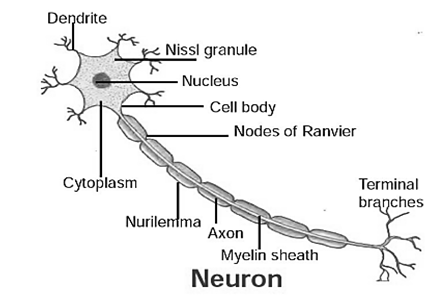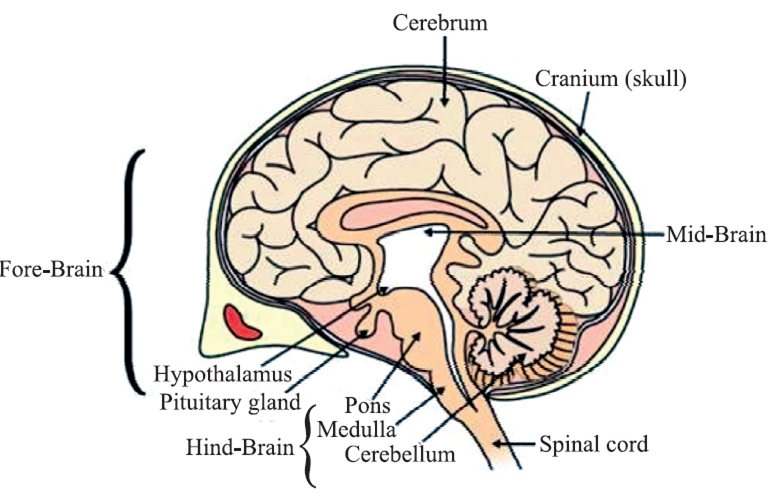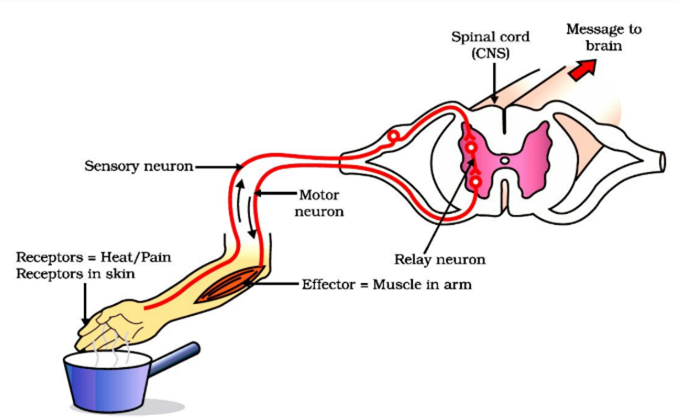CBSE
Class 10 Class 12
Control and coordination are provided by nervous and muscular tissues. Nervous tissue is made up of an organized network of nerve cells or neurons and is specialized for conducting information via electrical impulses from one part of the body to another.

Cell Body: It is the cell structure irregular in shape or polyhedral sturcture, it is also called as cyton. The cell body contains cytoplasm with typical cell organelles and certain granular bodies are called Nissl Granules.
Dendrites: Dendrites or Dendrons are shorter fibres which branch repeatedly and project out of the cell body. Dendrites transmit electrical impulse towards the cyton.
Axon: One of the fibres arising from the cell body is very long with a branched distal end and it is called as Axon. It transmits the electrical impulse from cell body to dendrite of next neuron.
The brain is protected by a fluid-filled balloon which acts as shock absorber and is enclosed in the cranium (skull or brain box).
When the action or movement is to be performed, muscle tissue will do the final job.
When a nerve impulse reaches the muscle, the muscle fibre move.
The simplest notion of movement at the cellular level is that muscle cells will move by changing their shape so that they shorten.
Muscle cells have special proteins that change both their shape and their arrangement in the cell in response to nervous electrical impulses. When this happens, new arrangements of these proteins give the muscle cells a shorter form.
The human brain is a highly complex organ; which is mainly composed of the nervous tissue. The tissues are highly folded to accommodate a larger surface area in less space. The brain is covered by a three-layered system of membranes; called meninges. Cerebrospinal fluid is filled between the meninges. The CSF provides a cushion to the brain against mechanical shocks.
Parts of the human brain

Functions of the various part of the brain:
| Parts of the Brain | Functions |
| Cerebrum | (i) Seat of metal abilities, control thinking, memory, reasoning, perception, emotions and speech. (ii) Interprets sensations and responds to cold, heat, pain and pressure. |
| Diencephalon | i) Relay centre for sensory impulses, such as pain, temperature and light. ii) Reflex centre for muscular activities. iii) Centre for certain emotions such as anger. iv) Centre for water balance, blood pressure, body temperature, sleep and hunger. v) The hypothalamus controls the pituitary gland, which functions as the master gland. |
| Midbrain | It relays motor impulses from the cerebral cortex to the spinal cord and relays sensory impulses from the spinal cord to the thalamus, reflexes for sight and hearing. |
| Cerebellum | i) Maintains posture, equilibrium and muscle tone. ii) Coordinates voluntary movements initiated by cerebrum. |
| Medulla oblongata | i) Contains centre for cardiac, respiratory as vasomotor activities. ii) Coordinates reflexes like swallowing, coughing, sneezing and vomiting. |
Reflex action is a special case of involuntary movement involuntary organs. When a voluntary organ is in the vicinity of a sudden danger, it is immediately pulled away from the danger to save itself. For example; when your hand touches a very hot electric iron, you move away from your hand in a jerk. All of this happens in flash and your hand is saved from the imminent injury.
This is an example of reflex action.

Need of Reflex Actions: In some situations such as touching a hot object, pinching etc. we need to act quickly, otherwise, our body would be harmed.
Reflex arc: The pathway through which nerve impulses pass during the reflex action is called a reflex arc.
 Response: Responses are of three main types :
Response: Responses are of three main types :